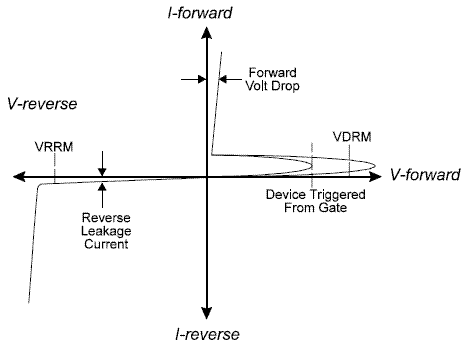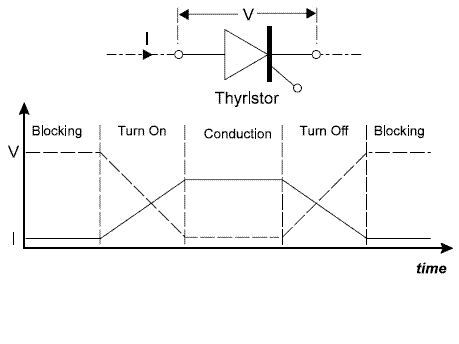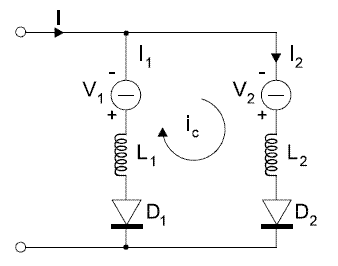- This topic has 1 reply, 1 voice, and was last updated 2 years, 11 months ago by .
-
Topic
-
During thyristor turn-off stage, after avalanche breakdown how depletion region starts reducing and returns to the original position, …
During thyristor turn-off stage, after avalanche breakdown how depletion region starts reducing and returns to the original position, if possible give me the answer in diagramatic form so that I may be able to understand, what actually happens during avalanche and how depletion region is reduced. I will be very thankful to you!!!!!!!!!!!
Viewing 1 replies (of 1 total)
Viewing 1 replies (of 1 total)
- You must be logged in to reply to this topic.

 The thyristor is turned off when it becomes reverse biased and/or the forward current falls below the holding current. This must be controlled externally in the power circuit. The transitional period from blocking to conducting, and vice versa, is called commutation and the period during which a component turns on/off, is called the commutation period. During commutation, the component comes under electrical stress due to changes in the circuit conditions and the thermal stress due to losses. These losses produce heat in the component and also stress the insulation and current paths.
The thyristor is turned off when it becomes reverse biased and/or the forward current falls below the holding current. This must be controlled externally in the power circuit. The transitional period from blocking to conducting, and vice versa, is called commutation and the period during which a component turns on/off, is called the commutation period. During commutation, the component comes under electrical stress due to changes in the circuit conditions and the thermal stress due to losses. These losses produce heat in the component and also stress the insulation and current paths.  In power electronics, the operation of any converter is dependent on the switches being turned ON and OFF in a sequence. Current passes through a switch when it is ON and is blocked when it is OFF. As mentioned above, the word commutation is used to describe the transfer of current from one switch turning OFF to another turning ON. In a diode rectifier circuit, a diode turns ON and starts to conduct current when there is a forward voltage across it, i.e. the forward voltage across it becomes positive. This process usually results in the forward voltage across another diode becoming negative, which then turns off which stops conducting current. In a thyristor rectifier circuit, the switches additionally need a gate signal to turn them on and off. The factors affecting commutation may be illustrated in the idealized diode circuit in Figure below, which shows two circuit branches, each with its own variable DC voltage source and circuit inductance. Assume, initially, that a current I is flowing through the circuit and that the magnitude of the voltage V1 is larger than V2. Since V1 > V2, diode D1 has a positive forward voltage across it and it conducts a current I1 through its circuit inductance L1. Diode D2 has a negative forward voltage across it and is blocking and carries no current.
In power electronics, the operation of any converter is dependent on the switches being turned ON and OFF in a sequence. Current passes through a switch when it is ON and is blocked when it is OFF. As mentioned above, the word commutation is used to describe the transfer of current from one switch turning OFF to another turning ON. In a diode rectifier circuit, a diode turns ON and starts to conduct current when there is a forward voltage across it, i.e. the forward voltage across it becomes positive. This process usually results in the forward voltage across another diode becoming negative, which then turns off which stops conducting current. In a thyristor rectifier circuit, the switches additionally need a gate signal to turn them on and off. The factors affecting commutation may be illustrated in the idealized diode circuit in Figure below, which shows two circuit branches, each with its own variable DC voltage source and circuit inductance. Assume, initially, that a current I is flowing through the circuit and that the magnitude of the voltage V1 is larger than V2. Since V1 > V2, diode D1 has a positive forward voltage across it and it conducts a current I1 through its circuit inductance L1. Diode D2 has a negative forward voltage across it and is blocking and carries no current.  Consequently, at time t1 I1 = I I2 = 0 Suppose that voltage V2 is increased to a value larger than V1, the forward voltage across diode D2 becomes positive and it then starts to turn on. However, the circuit inductance L1 prevents the current I1 from changing instantaneously and diode D1 will not immediately turn off. So, both diodes D1 and D2 remain ON for an overlap period called the commutation time tc. With both diodes turned on, a closed circuit is established which involves both branches. The effective circuit voltage VC = (V2
Consequently, at time t1 I1 = I I2 = 0 Suppose that voltage V2 is increased to a value larger than V1, the forward voltage across diode D2 becomes positive and it then starts to turn on. However, the circuit inductance L1 prevents the current I1 from changing instantaneously and diode D1 will not immediately turn off. So, both diodes D1 and D2 remain ON for an overlap period called the commutation time tc. With both diodes turned on, a closed circuit is established which involves both branches. The effective circuit voltage VC = (V2